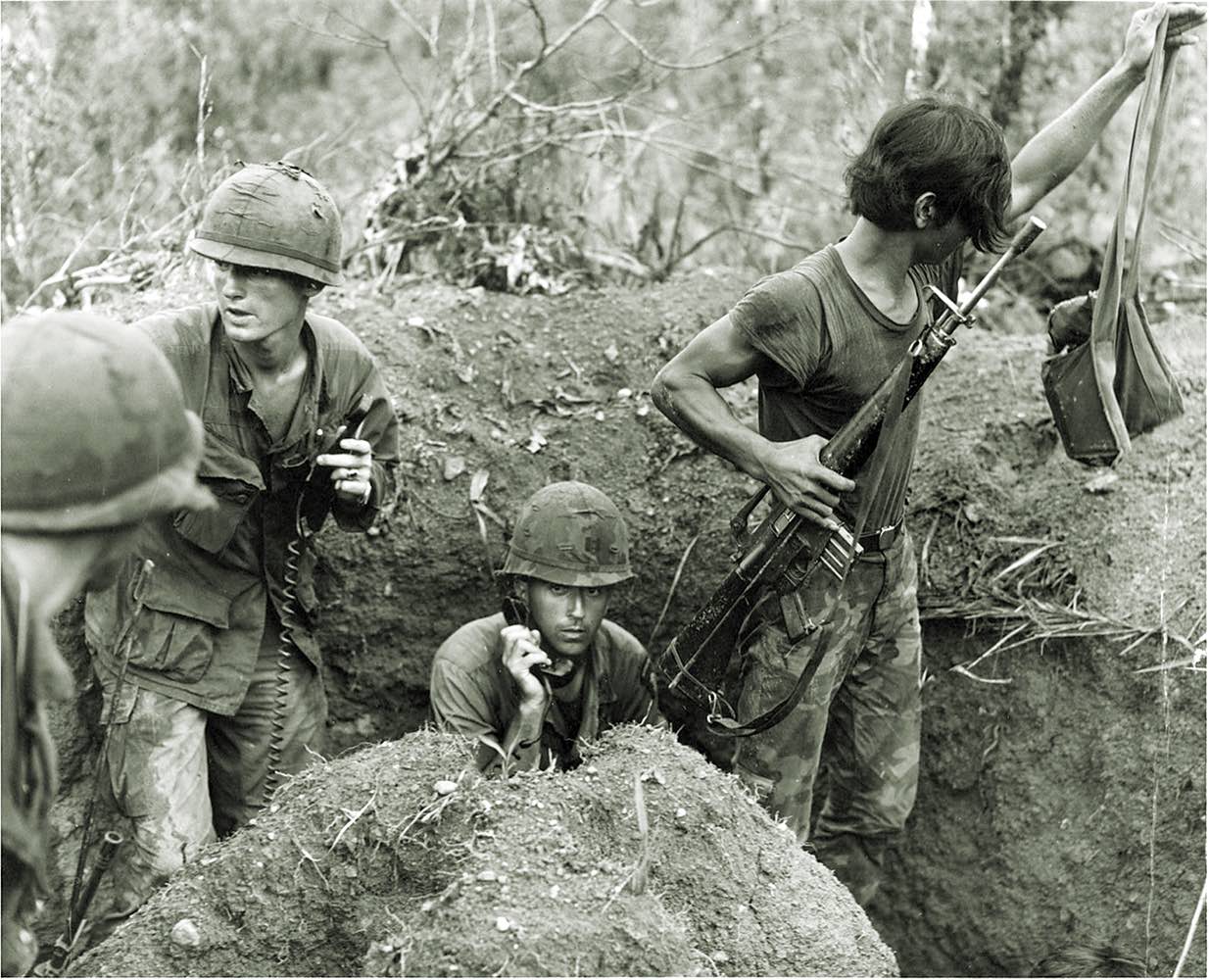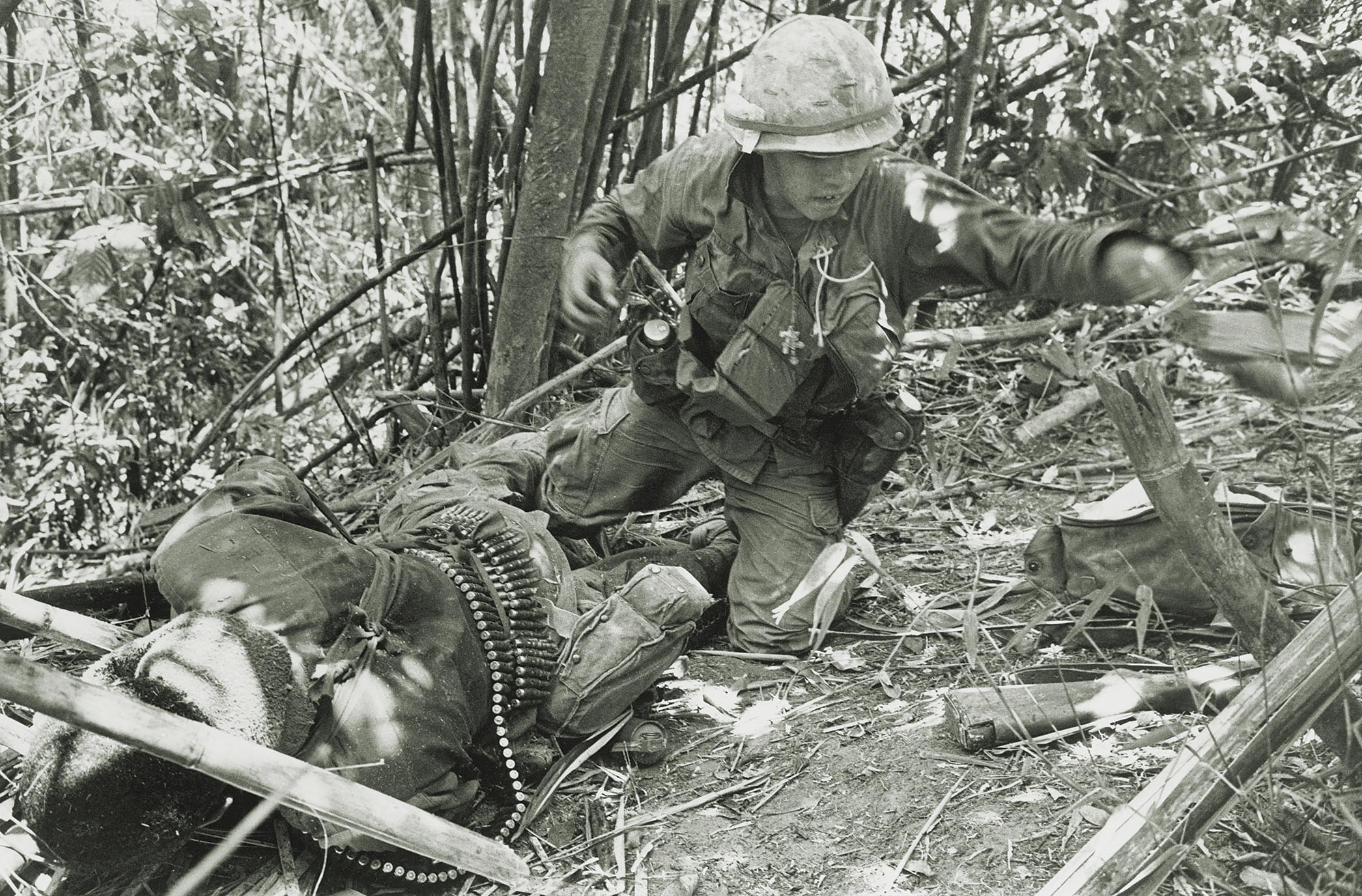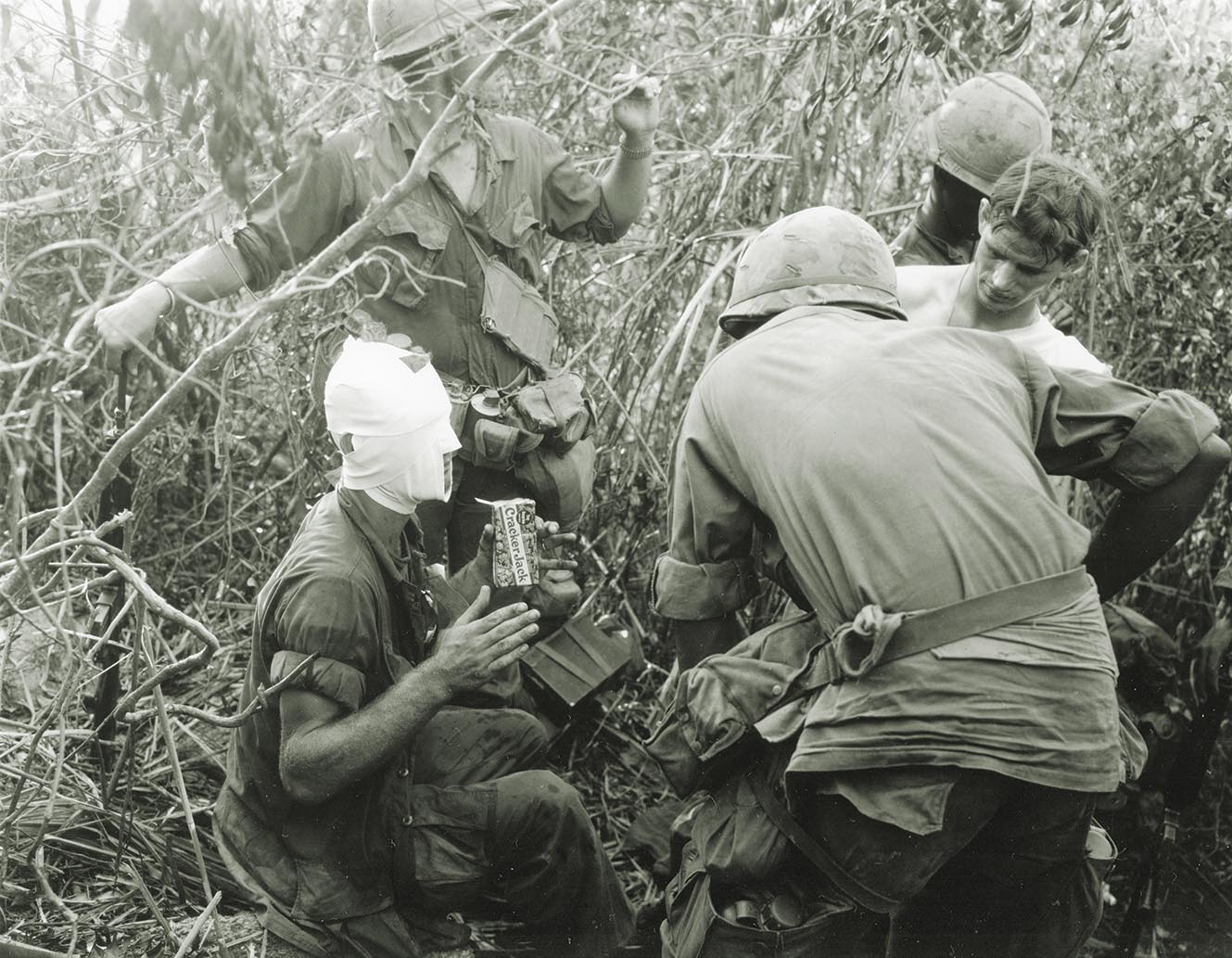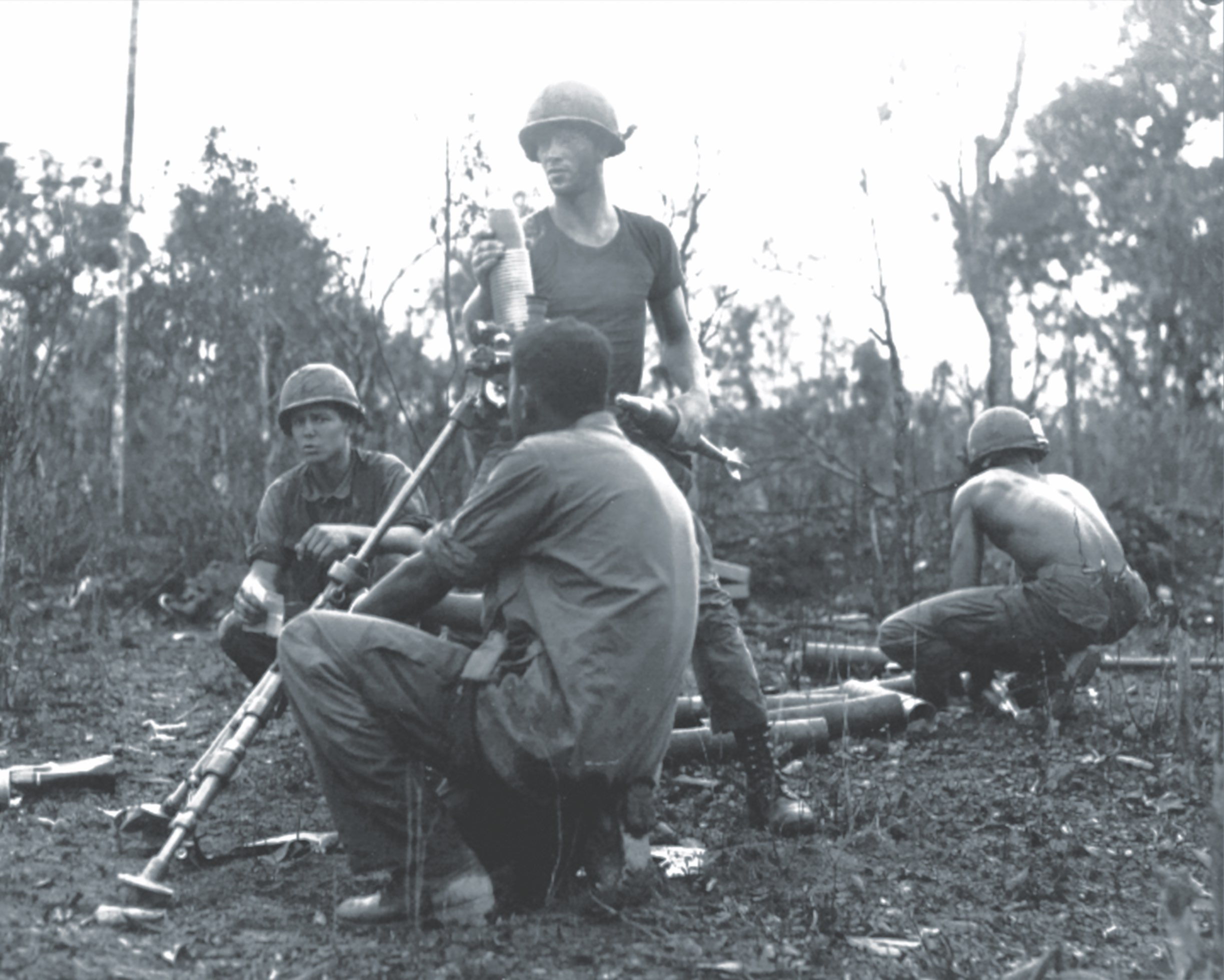On June 9, 1969, after weeks of bitter fighting, the 101st Airborne saw victory on the horizon
In early May 1969, the North Vietnamese Army and Viet Cong were threatening Tam Ky, the capital of Quang Tin province in northern South Vietnam. The U.S. Army unit with responsibility for that area, the 23rd Infantry Division (Americal), was unable to stem the enemy advance. Military Assistance Command, Vietnam, ordered the 101st Airborne Division to send in an airmobile brigade to destroy the enemy forces. The division chose the 1st Brigade, which went into action with its 1st Battalion, 501st Infantry Regiment, and 1st Battalion, 502nd Infantry Regiment, along with Americal’s 1st Battalion, 46th Infantry Regiment. Among the soldiers in what was officially called Operation Lamar Plain was Lt. Ed Sherwood, a platoon leader in Delta Company, 1st Battalion, 501st Infantry. In Courage Under Fire: The 101st Airborne’s Hidden Battle at Tam Ky, he gives a detailed, day-by-day account of his battalion’s actions during the operation, with a focus on Delta Company. Sherwood begins at May 15, the move to Tam Ky, and the first combat assault the following day. He ends with June 12, Delta’s extraction from Hill 376 a few days after a massive artillery barrage destroyed the enemy force. Delta had been fighting for control of the hill since June 3. On June 8, it seemed that little progress had been made. The next day would be crucial.
Today [June 9] will be a turning point, not an easy day, but a pivotal change for the better on Hill 376. Of course, no one knows it. Nothing in the last six days gives any hint that a breakthrough is about to occur. It is the nature of warfare. The decisive moment a favorable turn in a battle’s outcome occurs is often not recognized by those in the throes of fighting. Early morning events are a bad start for the day.
At 3 a.m., Alpha Company is shaken awake by the booming of 15 enemy 82 mm mortar rounds exploding in rapid succession. Sleep-deprived soldiers instinctively react to the unwelcome wake-up call. “Get down! Stay down! God please let me survive!” is the common thought. There is a collective sigh of relief when it is clear the rounds aren’t on target. The enemy gunners have overshot Alpha Company’s position, but not by much. No friendly casualties occur.
Each 82 mm mortar round has a lethal blast radius of 30-35 meters (33-38 yards). In open terrain, a single round’s blast can cover almost half the size of a football field. In mountainous, forested terrain the lethal blast area is reduced. Fifteen rounds are still a deadly barrage. Had it landed on Alpha Company, casualties would be high. Capt. Patrick McGuire, the company commander, has his forward observer call for artillery in the area from where they suspect the mortars were fired. Likely, the enemy mortar crews have already moved. They know return artillery fire will arrive soon.
At 3:50 a.m., Alpha’s artillery request is fired. An incoming 105 mm round falls short and explodes in Bravo Company’s position. The bursting shell kills three soldiers: Sgt. William Bushard, Sgt. William Sparks and Pfc. Larry Gilbertson. Pfc. David Bleeker is wounded and needs immediate care. A nighttime medevac is requested. At 04:25 a.m., the medevac is canceled due to dangerous flying conditions.
Capt. Leland Roy hears the enemy mortars hitting Alpha Company over the battalion radio net. The delayed muffled booms rapidly echo across the mountainside. It is an ominous, unwelcome sound. Roy recalls the enemy attack mentioned in the recent intelligence report. The attack is to begin tomorrow, June 10. Maybe this is it, a day early. If he is right, the battle action on Hill 376 will soon get more intense. The early morning hours before sunrise are peacefully quiet. It is an illusion.
Finding a landing zone for Charlie Company is the first of Delta Company’s morning tasks. Soon after first light, Roy adds several Delta Company soldiers to the attached Reconnaissance Platoon (now no bigger than a reinforced squad). He sends them out 200 meters (220 yards) to the southwest of Delta Company’s position to search for a suitable LZ. The battalion plan from yesterday to have Charlie Company relieve Delta Company was postponed. Delta Company’s enemy contact prevented their move south to the proposed pickup point. Roy still believes the solo move south by his understrength company is too risky with an enemy attack expected soon.
The Recon element moves out of Delta’s perimeter to see if a long ridgeline running southeast off Hill 376 may be a suitable LZ. It seems capable of handling five or six helicopters at a time, and it will take 15 Hueys to bring in Charlie Company. As each of Charlie’s lifts arrive, Delta will load up the empty helicopters with their own men for extraction. At least, that is the plan.
While Recon is still scoping out the potential LZ, the air commander responsible for Charlie Company’s movement vetoes the location. He tells Roy the proposed LZ on the ridge line will expose inbound and outbound helicopters to the enemy’s 12.7 mm heavy machine-gun fire. Roy then quickly recommends and gets approval for using a much smaller, one-ship LZ adjacent to his company’s position.

The approved LZ is small and cramped. Only one Huey can land at a time and after unloading must do a 180-degree turnaround to fly out. With some needed brush cutting, it will have to do. The LZ has two advantages. It is close by Delta Company’s position and can be covered by fire from the company’s perimeter. It is also in a swale with high ground immediately to its north and south, which provides protection from enemy observation and anti-aircraft fire. The Hueys can approach the LZ from the south and fly out on the same route.
Staff Sgt. Ronald Sahrle, who is leading the remnants of 1st and 2nd platoons, takes on the task of clearing brush to widen the LZ and enlists Sgt. Jim Littleton in 3rd Platoon to provide a three-man team with machetes. Littleton will also take a security team several hundred meters to the west of the LZ to cover the likely direction from which an enemy attack may come.
Sgt. Robert Clouatre, Spc. 4 Terry Rada and Pfc. Steve Strand, all from 3rd Platoon, begin work with machetes clearing the west end of the LZ. Some 20 meters (22 yards) away and just above them on the high ground to their north is a berm running parallel to the LZ from east to west. It is 70 meters (77 yards) long and 8-10 feet high. Overgrown with vegetation, the berm is part of an abandoned terraced area once used for farming.
At 07:15 a.m., the morning’s humid temperature is rising. Clearing the LZ is hot work. Rada is sitting down for a short break. Strand is standing 6 feet behind him, Clouatre is standing near to the side of Rada. Their weapons are nearby. Without warning, an enemy grenade explodes just in front of Rada, killing him instantly. It is thrown from a concealed enemy position on the west end of the berm up above the LZ. Strand and Clouatre are both wounded, Clouatre seriously. He will survive, but will require hundreds of stitches and several operations.
Roy is on the LZ checking the progress of the brush clearing just 30 feet to the east of when the enemy grenade explodes. Doc, the company medic, bolts out from the company perimeter to the wounded men. Roy knows the medic and the wounded men are in danger and yells for them to pull back to the company’s perimeter. Soldiers on the company’s southwestern perimeter begin providing suppressive fire on the berm to cover their withdrawal. Strand and the medic help move Clouatre to safety. Rada is carried by others who have come out to help.
The enemy position near the west end of the berm is continuing to fire AK-47s. Roy estimates by the firing there are several enemy soldiers, maybe more. Fortunately, the enemy is not positioned on the military crest of the hill. They are unable to see directly down to the wounded soldiers on the LZ or take them under fire as they make their way back to Delta’s defensive position. The suppressive fire from Delta’s perimeters keeps them from improving their position. Otherwise, there would be several more casualties.

Once within the perimeter, Doc treats Clouatre with Strand’s help. It takes more than a few minutes since Clouatre is bleeding badly from multiple shrapnel wounds. Doc makes sure he hasn’t overlooked any life-threatening wounds and applies bandages to the worst of them. When done, Doc notices Strand has bled through his jungle fatigues jacket. His rolled-up right sleeve is saturated with dark red blood. Once bandaged, Strand is surprised when Doc tells him he will also go out on the next medevac. That won’t happen until the enemy contact has ended. In the meantime, Littleton’s security team is told to return, and they make it back without incident.
While Strand waits for a medevac, his thoughts turn to Rada. They were good friends. Rada was well liked by his platoon members. Before Tam Ky, he was a top-notch radio telephone operator for Staff Sgt. Gary Tepner, 3rd Platoon’s former platoon sergeant. His slight, wiry frame and average height belied his strength. Rada could easily carry his 50-pound rucksack and 35 pounds of radio and batteries even in mountainous terrain. He wore military issue, heavy, black-framed glasses, had reddish, short-cropped hair and a quick wit. When he returned from R&R a few weeks back, he asked to give up his RTO job and be a rifleman in the platoon with the guys. He got his wish. He was a great soldier, fondly remembered by all who knew him. Tepner will soon hear of his death with deep regret and sorrow.
Roy and Lt. Paul Wharton, the captain’s crackerjack artillery observer, take up a position on the southwestern edge of Delta’s perimeter next to a huge rock that towers over them. The top of the rock is a perfect place for locating the large international orange panel that marks their position for friendly aircraft. From their vantage point, both Roy and Wharton can observe the enemy position on the berm about 50 meters (55 yards) away. The enemy continues to fire sporadically. For a welcome change, it is not well-aimed. No one is hit. For once, they have strangely encountered enemy soldiers who can’t seem to shoot straight.
The Recon element is still out. Roy radios for them to immediately pull back and take cover. Just as they begin to withdraw, no more than 50 meters away they spot a large enemy force of undetermined size moving east among the trees. The enemy also sees Recon and begins to fire at them with small arms and rocket-propelled grenades. Recon knows their small element is in great danger of being overrun. Pfc. Ken Hornbeck, a Delta soldier serving as the Recon RTO, calls in and yells they are surrounded by a “horde of enemy soldiers.” This is likely part of the enemy’s general offensive that has been expected. It may be more than expected.
Later, it is estimated the enemy is a reduced-in-strength battalion from the NVA regiment defending Hill 376. Perhaps it is as many as 200 soldiers, maybe more. A recently captured enemy soldier reported their casualties had reduced their companies to around 60 men. The enemy’s location, numbers and direction of movement indicate they are likely massed for an attack on Delta Company’s position. The enemy attack from the berm seems to have been a diversionary attack, a planned distraction to allow the larger enemy force to make a surprise attack from a different direction. The easterly movement by the main enemy force indicates they are getting into position to attack Delta Company from the north. It appears the firing from the berm began too early, before the larger force was in position to attack. A fatal mistake.
As Recon makes their way back, they are firing and moving. Reaching a position in the tree line near the eastern end of the berm, they can go no farther. They are a hundred or so meters from Delta Company’s defensive position and safety. The two medics in Recon, Spc. 4 Gary Winkler and Spc. 4 Daniel Thurston, are in trouble. They normally are at or near the rear of Recon when the unit is moving. In case a Recon soldier is wounded, they can easily go forward to treat the soldier. This time they are the ones in danger.
Thurston is wounded and unable to move. In the rush to pull back, no one sees that he is hit. He has not made it to the tree line with the others. He calls out to his fellow medic and close friend, Winkler. Winkler stops and quickly decides to stay with Thurston. It is an unselfish act typical of medics whose first instinct is to stay with, treat and protect the wounded.
The enemy continues to advance from the northwest on Delta’s position, hidden from direct observation from Roy and Wharton’s position. They quickly overrun Thurston and Winkler’s position and are closing in on Recon’s position. Just then, the cavalry arrives, just like in the movies. This time it is for real.
Wharton is on two radios. Handset in each hand. One held to each ear. He has been talking with the 101st Airborne’s air cavalry team, which was loitering nearby. On the other phone is the artillery fire direction net. He is also setting up and sequencing artillery fires. The immediate target is the enemy position on the berm, 50 meters to their front. Wharton directs the Cav team to make several runs along the berm with miniguns from east to west. As usual, the fires are danger close to Delta Company and the Recon Team. Wharton uses the berm to direct their fires. The Cav team is to keep its fires along the berm and not extend its firing beyond the two ends of the berm.
The high-decibel onslaught of the light observation helicopter and two AH-1 Huey Cobra attack helicopters is much louder that the uninitiated could possibly imagine. The rotors, engines and deep-throated roar of almost continuous minigun fire is impossible to describe. Movies, television or video games aren’t even close. To say it is oppressively loud and violent is only a start. The air reverberates with ear-splitting sounds.
A fire started by minigun tracers breaks out on the berm. It spreads quickly, fanned by the rotor wash and wind and soon engulfs the length of the berm. Smoke and dust clouds along the berm are blown by the rotors and the wind. Smells of cordite, splintered and torn vegetation, and newly overturned earth permeate the air. Time and again well-bunkered NVA soldiers survive such attacks, but not this time. The enemy firing from the berm quickly ceases. At 8:45 a.m., the Cav team goes off station to rearm and refuel.
While the Cav attacks the enemy position on the berm, the enemy force stops its advance and takes cover. Once they begin moving again, the Recon team is in danger of being overrun. The burning berm is between Recon and Delta Company. Recon requests permission to drop their rucksacks and make a run for it. They will run through the smoke and flame just as soon as the Cobra helicopters finish their attack. Roy gives them the OK.
As the Air Cav helicopter team completes its attack, Sahrle and a small group of his soldiers higher up on the hill within Delta Company’s perimeter can see the Recon Team. Behind the team, they catch sight of enemy soldiers moving in the trees and closing in on Recon. They are heavily camouflaged with vegetation stuck in their helmets, web gear and packs, and practically invisible until they move. From Sahrle’s position, their easterly movement is from left to right in an attempt to flank Delta Company’s position on the north before beginning their attack.

Sahrle and his men begin yelling at Recon, “Get out of there! Run for it! Let’s go!” The Recon soldiers drop their rucks and sprint as hard as they can go the 100 meters (109 yards) to Delta’s perimeter. Only afterward is it known the Recon’s two PRC-25 radios are purposely left behind by the RTOs to lighten their load. At least they remembered to twist the dials to make sure the enemy couldn’t detect the radio frequencies being used. As soon as the Recon team is clear of the hill, Sahrle and several others open fire on the enemy force with their M16s. The enemy doesn’t return fire. They are still not wanting to disclose their position in the trees as they close in for the attack.
Pfc. Lyle Stoner is with 3rd Platoon in Delta Company’s perimeter. He sees the Recon team’s frantic flight through the heat of the burning berm fire and broiling sun. They are exhausted. Several suffer from heat exhaustion. They collapse inside the perimeter. Doc enlists Stoner to help treat those who are in the worst condition. He tosses a saline solution bag from his medical kit to Stoner. He points to a prostrate soldier and tells him to plug it into his arm.
Stoner looks at the bag, the soldier and then back to Doc. He has never done an IV before. Doc reassures him, “I’ll talk you through it.” One step at a time, Stoner follows the medic’s instructions, “Put the tourniquet on his upper arm good and tight. Next, find a vein on his arm below the tourniquet. Should be one around the inside of his elbow. Take the needle and stick it in the biggest vein you see.”
Stoner complies. It takes him three sticks to get a vein. The barely conscious soldier is too exhausted to complain. The needle is in. Stoner tells the medic, “Nothing’s happening!” Doc tells Stoner, “Loosen the tourniquet.” That works. The saline solution begins to flow. Twenty minutes later the soldier comes around.
Jokingly, Doc tells Stoner, “I’ll put you in for a Combat Medic Badge!” Stoner smiles and gives a quick, “No thank you!” Quietly, he is glad he could help. That is what good soldiers do. Whatever it takes. The Recon team is done. They are still suffering effects of heat exhaustion. They are also now without their equipment and radio. Roy decides to put them on the next helicopter out. They’ve performed a vital mission. Their early identification of the enemy force moving toward Delta Company saved many lives.
At that time the enemy force was within 100 yards of Delta Company. American artillery from nearby firebases was cranked up. A Navy ship in the South China Sea added its guns to the fight. Massed fires of three batteries and the Navy destroyer created “the most awesome firepower display Delta Company soldiers have ever seen, heard, felt, or even imagined,” Sherwood writes and adds: “The results of the destructive force of massed artillery fires won’t be known until tomorrow. What is obvious immediately is the enemy attack hasn’t and won’t reach Delta Company’s position.” Operation Lamar Plain officially ended on Aug. 13. V
After Vietnam, Ed Sherwood served as an infantry officer in assignments in the 3rd Armored Division in Germany, the U.S. Army Infantry School and the 197th Infantry Brigade at Fort Benning, Georgia. He retired from active duty as a lieutenant colonel in 1988.
This article was published in the February 2022 issue of Vietnam magazine.
This post contains affiliate links. If you buy something through our site, we might earn a commission.





